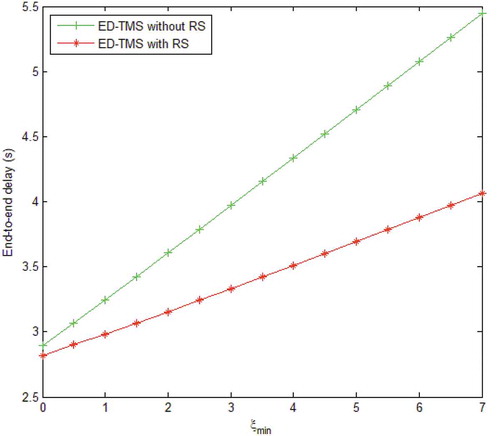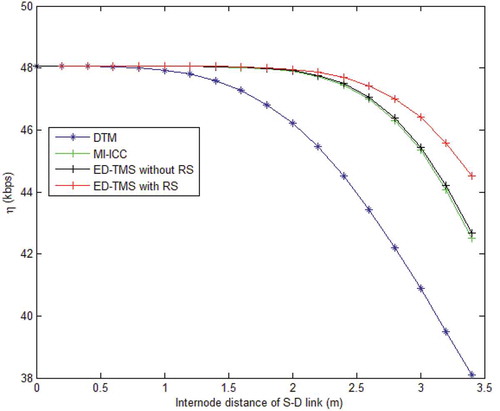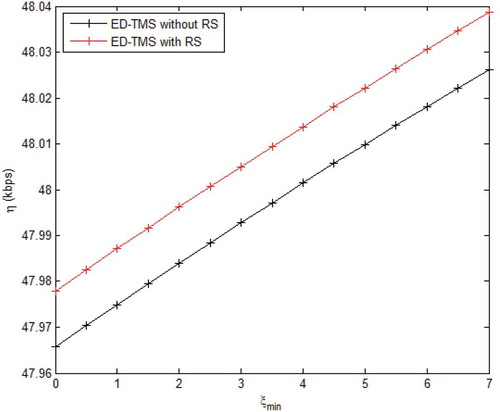 ?Mathematical formulae have been encoded as MathML and are displayed in this HTML version using MathJax in order to improve their display. Uncheck the box to turn MathJax off. This feature requires Javascript. Click on a formula to zoom.
?Mathematical formulae have been encoded as MathML and are displayed in this HTML version using MathJax in order to improve their display. Uncheck the box to turn MathJax off. This feature requires Javascript. Click on a formula to zoom.Abstract
The main differences between wireless body area network (WBAN) and wireless sensor network are the sensors in WBAN distributed on the human body; therefore, body posture, clothing, muscle movement, body temperature, and climatic conditions generally influence the links between sensors and destination. Second, data gathered by the sensors are related to human life; therefore, it is important to make sure that the gathered data should be delivered to destination efficiently. Hence, in some cases, single-hop transmission or direct transmission mode (DTM) is not sufficient to deliver the data to the destination. In this paper, we proposed an emergency-based cooperative communication protocol for WBAN, named as Emergency Data Transmission using Transmission Mode Selection (ED-TMS) protocol based on the IEEE 802.15.6 CSMA. First, a complete study of a system model is inspected in terms of channel path loss, successful transmission probability, and the outage probability. Second, a mathematical model of the proposed protocol, end-to-end delay, and throughput with relay selection (RS) is derived. Third, RS is utilized along with ED-TMS, which makes only the best relay participate in cooperation in a distributed manner. The design objective of the ED-TMS is to reduce end-to-end delay and enhance the throughput of direct transmission and traditional cooperative communication. The simulation and numerical results show that the ED-TMS can enhance network performance under general conditions compared to DTM IEEE 802.15.6 CSMA and benchmark. The end-to-end delay reductions of ED-TMS with RS with respect to DTM, mutual information incremental cooperative communication, and ED-TMS without RS are 24.5%, 28%, and 30%, respectively.
Public Interest Statement
Wireless body area sensor network has a huge potential to revolutionize the future of health-care monitoring by diagnosing many life-threatening diseases and providing real-time patient monitoring. Demographers have predicted that the worldwide population aged over 65 will have doubled in 2025 to 761 million from the 1990 population of 357 million. This implies that by 2050, medical aged care will become a major issue. Where sensors in such network attached on/in and off the body, each sensor equipped with a wireless transceiver. The equipped transceiver utilizes radio frequency to transmit the gathered data. The wireless channel is error prone that sometimes makes the direct transmission not possible. In this work, we proposed a method that allows sensors to cooperate with each other to deliver the data efficiently.
1. Introduction
Wireless body area networks (WBANs) are communication networks of sensor nodes (and/or actuators) placed on, inside, or around the human body that show a new generation of WPAN and introduce several challenges for implementation. Sensor nodes in WBANs are small and embedded with finite source compared to devices in the traditional wireless sensor network. Finite source makes a limitation on the energy spent by sensor nodes in sensing, processing, storing, and delivering the data (Arain & Ghani, Citation2016; Cavallari, Martelli, Rosini, Buratti, & Verdone, Citation2014; Hayajneh, Almashaqbeh, Ullah, & Vasilakos, Citation2014; Khan & Pathan, Citation2018; Liu, Yuen, Cao, Hassan, & Chen, Citation2014; Mahapatra, Nijsure, Kaddoum, Hassan, & Yuen, Citation2016).
The end-to-end delay and throughput are the key factors to determine the overall performance of a WBAN. The most suitable layers to address the aforementioned factors are data link layer, such as medium access control (MAC) protocol and physical layer (such as virtual diversity technique) (Abbasi, Rehman, Qaraqe, & Alomainy, Citation2016; Alomainy, Bari, Abbasi, & Chen, Citation2014; Rasheed et al., Citation2017). MAC protocol is controlling and organizing sensor node access to the wireless shared medium. MAC protocol is an essential protocol which considers the basis for setting Quality of Service, high data rate, and higher energy saving in any wireless networks. In addition, the MAC protocol is preventing collisions and concurrent sending while conserving data rate, reducing end-to-end delay, enhancing the reliability, and saving the energy (Chavez-Santiago et al., Citation2013; Khan, Ullah, Alam, & Kwak, Citation2015; Tachtatzis, Di Franco, Tracey, Timmons, & Morrison, Citation2010; Ullah, Imran, & Alnuem, Citation2014).
Diversity technique is the method to combat the effect of the fading of the wireless channel; diversity can be achieved through either embedded sensor node with multiple antennas or using cooperative communication (CC) (Elfituri, Hamouda, & Ghrayeb, Citation2009; Ibrahim, Sadek, Weifeng, & Liu, Citation2008). Various types of CCs are considered in WBANs to improve their performance in terms of power saving, reliability, and end-to-end delay. Whereas in the conventional CC, a source sends data to a one of the on-body sensor nodes and to the destination, and then the intermediate node(s) (relay(s)) retransmit what was sent by the source node to the destination (Nhu, Bao, & Beongku, Citation2016). However, such CCs utilized extra sub-channels/time slots to transmit single data from the source to the receiver which increases the delay and reduces the bandwidth efficiency of wireless channels (Alkhayyat & Sadkhan, Citation2018; Alkhayyat, Gazi, & Sadkhan, Citation2015). Therefore, it is possible to solve the aforementioned problem of the conventional CC by utilizing an incremental cooperative communication (ICC) in such a way that the relay node does not participate in cooperation until the destination does not receive what was sent by the source correctly (Alkhayyat, Citation2015). CCs have been widely considered in the literature for WBAN systems (Cui, Sun, Wang, & Yuefeng, Citation2017; Rout & Das, Citation2016b, Citation2017; Rout, Gurrala, & Das, Citation2016; Shimly, Movassaghi, & Smith, Citation2016; Wei, Sun, & Yuefeng, Citation2017; Yan, Peng, Shen, Yan, & Deng, Citation2018; Zhang, Zhang, & Zhang, Citation2017); however, in this paper, only the ICC is surveyed.
Different CCs were considered for WBAN to improve their throughput and end-to-end delay. Deepak and Babu (Citation2015) investigated the energy efficiency of an incremental relay-based cooperative communication in WBANs, and they considered two communication models: the in-body communication between implant sensors and the gateway and on-body communication between a body surface node and the gateway with line-of-sight (LOS) and non-LOS channels. Manirabona, Fourati, and Boudjit (Citation2015) proposed a Decode and Merge method which maintains the relaying mode by merging frames from relayed and relaying nodes. The throughput has been studied with keeping the energy consumption unchanged. Esteves et al. (Citation2015) introduced a cooperative MAC protocol, named cooperative energy harvesting-MAC, that adapts its operation to the energy harvesting conditions in WBANs. In Lalos et al. (Citation2015), Link-Aware and Energy Efficient protocol for WBANs (LAEEBA) and Cooperative Link-Aware and Energy Efficient protocol for WBANs (CoLAEEBA) routing protocols are presented, and they have investigated the throughput and the network lifetime.Ahmed et al. (Citation2015) introduced a cooperative compressed sensing approach, which takes into account the energy efficiency of WBANs by exploiting the benefits of random linear network coding (RLNC). Hiep, Hoang, and Kohno (Citation2015) analyzed and investigated the performance of multiplehops in WBANs that was based on the IEEE 802.15.6 standard. The authors analyzed the performance of multiplehops in WBANs, which include multiple node sensors and have many hops according to the power transmitted, the distance between the sensors, and the distance between the sensors and the coordinator. The proposed technique considered the power consumption and compared their protocol with the star-topology scenario. Rout and Das (Citation2016a) developed a multi-relay, ultra-wideband (UWB)-based Body area network (BAN) system. Theoretical and simulation results based on IEEE 802.15.6 with a CM3 channel model were analyzed and discussed. The work generally focused on the study of Amplify-and-Forward and Decode-and-Forward relaying and direct transmission for WBANs in the 3.1–10.6 GHz UWB band. Yousaf et al. (Citation2016) proposed proactive relay selection (RS) for both on-body and in-body WBANs. The results showed that a three-relay, incremental cooperative communication performed better in terms of the probability error rate. Cui, Sun, Wang, and Ji (Citation2017) proposed a joint RS and power control scheme (JRP) that takes into account transmission reliability. The proposed protocol achieved a good trade-off between reliability and energy consumption. In Liao, Leeson, Cai, Ai, and Liu (Citation2018), a mutual information incremental cooperative communication (MI-ICC) protocol is presented, where several on-body relay nodes and one coordinator are attached to the clothes of a patient. MI-ICC achieves better performance in comparison to the two-relay based scheme. Here, the residual energy and network lifetime are taking into account and have improved.
In what follows, the drawbacks and limitations of Ahmed et al. (Citation2015), Cui et al. (Citation2017), Esteves et al. (Citation2015), Hiep et al. (Citation2015), Ibrahim, Han, and Liu (Citation2008), Lalos et al. (Citation2015), Liao et al. (Citation2018), Manirabona et al. (Citation2015), Rout and Das (Citation2016a), and Yousaf et al. (Citation2016) are shown in Table . The limitation of Ahmed et al. (Citation2015), Cui et al. (Citation2017), Deepak and Babu (Citation2015), Esteves et al. (Citation2015), Hiep et al. (Citation2015), Lalos et al. (Citation2015), Liao et al. (Citation2018), Manirabona et al. (Citation2015), Rout and Das (Citation2016a), and Yousaf et al. (Citation2016) can be summarized as follows: MAC protocol was not considered (IEEE 802.15.6), end-to-end was not analyzed, best relay node selection is not considered, throughput is not analyzed, and types of gathered data. To address the aforementioned issues and facilitate CC in WBAN, we propose a novel Emergency Data Transmission using Transmission Mode Selection (ED-TMS) protocol based on the IEEE 802.15.6 CSMA. The contributions of this work are summarized as follows:
A MAC protocol for the ED-TMS is proposed to coordinate the sensor nodes to act as relay nodes to carry out the retransmission process.
Transmission mode selection is considered, where cooperation transmission mode is selected only if the source to destination link is worser than the source to relay and relay to destination links. The best relay is selected to participate in cooperation along with cooperation transmission.
Gathered data nature has been taking into account, where critical data transmitted over ICC and normal data transmitted over direct transmission mode (DTM).
The end-to-end delay and throughput are mathematically modeled and analyzed along with ED-TMS. We show that the proposed protocol can reduce the end-to-end delay and enhance the throughput of the WBAN compared to the existing work and DTM under IEEE 802.15.6 CSMA policy.
The rest of the paper is organized as follows: System model and architecture is presented in Section 2. Section 3 describes and investigates the wireless link and successful transmission probability under the shadowing model. Then, modeling and formulating of ED-TMS in detail have been described in Section 4. In Section 5, end-to-end delay and throughput of ED-TMS are investigated, formulated, and analyzed. Simulation and numerical results are addressed in Section 6. Finally, Section 7 draws the conclusion and future work.
Table 1. Comparison of state-of-the-art work
2. WBAN architecture
There are many sensors uniformly distributed around the body to monitor the health status, and each of the sensors gathered and sent data to the master node (MN). Where a WBAN that is based on the single-hop star topology, all the sensors send their data directly to the MN. The MN, then, send its data to the monitor node, which either analyze the received data or forward the data over the Internet to the hospital or doctors. Figure ) shows an example of a traditional WBAN system.
Figure 1. Communication architecture for WBAN sensors: (a) traditional architectures and (b) cooperative communication architectures.
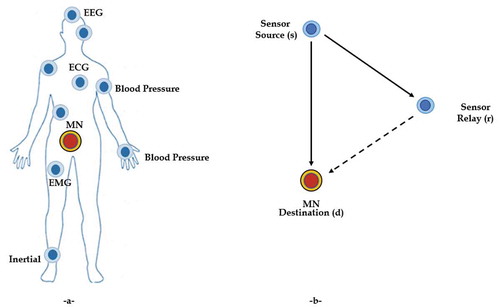
In the WBANs, it should consider a number of physical environments, due to the networks are configured on/in the body. Where the sensors are attached to the human body which is mobile that make the sensors owing numerous body movements. Therefore, the distances between the sensors and MN are varying. Some sensors may have a large distance or weak link to the MN, and thus, transporting the data sufficiently to the MN in a single hop is difficult.
A CC is considered one of the best solutions to overcome the aforementioned problem, i.e., single-hop transmission. Various CC modes are widely inspected in the literature. However, the ICC is considered in this work, and it is summarized as follows: if the MN (or destination) received the data packet correctly from source (), then it sends an acknowledgment (ACK) to the
and the relay sensor (
) drops what received from
. Otherwise, it sends a negative acknowledgment (NACK) that allows the
retransmit what was received from the
, but MN drops what received from the
. The cooperative scenario is shown in Figure ). In what follows, the distances from
to MN,
to
, and
to MN are denoted as
,
, and
, respectively, and we denoted link between sensor and MN as
, link between source and relay sensor as
, and link between relay sensor to MN as
.
3. Link and outage probability analysis
In this section, the propagation model, the link analysis, and outage probability over the link are described. The signal-to-noise ratio (
) of the
link can be expressed as:
where is the transmission power,
is a multiplication of all antennas' gain,
is the noise power, and
is a complex Gaussian random variable with unit variance. Hence, the channel gain
is an exponentially distributed random variable with the mean value,
, where E denotes expectation, the
is the distance of the
link,
is the path loss factor which varies from
, which is described as fluctuations of the amplitude of a radio signal at the receiver. The transmission rate over
link can be expressed as:
where is the transmission channel bandwidth and is set to unity. The outage probability is defined as the probability that the transmission rate is less than or equal the required transmission rate
. The outage probability can be expressed as (Ibrahim et al., Citation2008):
where Consequently, the successful transmission probability of the
link can be expressed as
4. Reliable emergency data transmission using transmission mode selection
4.1. Proposed method description
In this paper, it has been proposed an efficient protocol to transmit emergency data reliably for WBAN, named as Emergency Data Transmission using Transmission Mode Selection (ED-TMS). The proposed protocol work in a cooperative fashion by considering emergency data and utilizing the principle of the automatic repeat request (ARQ). The ED-TMS has two events, and it is summarized as follows:
The first event is Emergency Data Event (denoted as X), and it occurs when data gathered by the sensor are critical and it should be transmitted for the destination efficiently. In such case, critical data transmitted either through a direct path, which is a source to the destination, or through the relay path, which is the source to relay and then relay to the destination.
The second event is Normal Data Event (denoted as Y), and it occurs when gathered data by the sensor are normal or not critical and it could be transmitted directly to the destination without the need to the relay path.
4.2. Formulation of the ED-TMS
As described earlier, the ED-TMS comprises two events, and it is mathematically expressed as
where is the probability of the gathered data was critical. The critical data transmitted through either the direct path or the relay path, and it is mathematically expressed as
where the is the critical data index, and it is mathematically expressed as
where is the absolute notation,
is the maximum critical data index and it equals to 7, and
is the minimum critical data index and it varies between 0 and 7. Therefore,
varies between
and 1. Where
depends on the gathered data from the human body, if the data are critical, then
is high and vice versa. Table shows the probability of the critical data index with a different value of
.
The is the successful transmission probability of the cooperative transmission mode with RS, and it can be expressed as:
where ,
, and
represent
,
, and
links that are in the outage. In addition,
is the probability of the
link greater than the maximum of the minimum of the
and
links, and it can be expressed as:
then,
where is the selected relay index in conventional relay networks over
potential relays, and
and
are random variables of
and
links, respectively. Thus, the relay is chosen based on the channel gains of the relaying links. In the sequel, the cumulative distribution function of two independent random variables can be expressed as:
Taking the average of over
, thus the average of the
is expressed as:
the , then re-write Equation (12) as
with the help of Equation (3), substitute Equation (13) in Equation (8), we obtain as
then, substitute Equations (7) and (14) in Equation (6), we obtain emergency data event ) as
In what follows, nonemergency data event is , and it is given as
Finally, substitute Equations (16) and (15) in Equation (5), we obtain the ED-TMS probability.
5. Delay and throughput analysis of ED-TMS
5.1. Delay analysis of ED-TMS in WBAN
The average end-to-end delay of the protocol IEEE 802.15.6 of ED-TMS is evaluated in this subsection. Where the average end-to-end delay is defined as the total time required of the medium access delay to transmit data and includes average contention time due to collision (), the average successful transmission time with no collision and no fading (
), and average failure time due to fading but no collision (
) (Khalid, Wang, Ra, & Sankar, Citation2011).
average contention time due to collision can be expressed as:
where is the RF activity time, which can be expressed as:
where the time required to transmit data packet can be expressed as:
the transmission time required for can be expressed as:
where average backoff time, and it can be expressed as:
Average successful transmission time with no collision and no fading can be expressed as
Equation (23) comprises two terms. The first term is end-to-end required time of the transmission when the data gathered by the source were critical, which are transmitted via CC including RS. The second term is end-to-end required time of the transmission when the gathered data by the sensor were not critical, which are always transmitted over DTM.
It is clear from Equation (23)that as the approaches to 1, then either
is the required time to transmit the data or
is the required time to transmit the data to the destination. However, as the
approaches to zero, then
is the required time to transmit the data to the destination.
are the RF activity time of the relay sensor to serve source sensor data retransmission and it is equal to
. Finally, the average failure time due to fading but no collision can be expressed as
It is clear from Equation (24) that the the first term corresponds to the events when the and
links in the outage, while
link not in the outage. The second term corresponds to the events when the
and
links in the outage, while
link not in the outage. The last term corresponds to the events when the
,
, and
links in the outage. In Equation (24), we did not include the
because channel fading does not affect by the types of the gathered data whether it is critical or not.
The transmission rate of the PHY, MAC headers, and payload is depending on the channel condition between nodes (Liu, Tao, Narayanan, Korakis, & Panwar, Citation2007). The with ED-TMS can be expressed as
Where is the maximum transmission rate of IEEE 802.15.6 standard and it is
Kbps for DPSK modulation. The following abbreviation and acronyms are used for the above times.
Table
5.2. Throughput analysis of ED-TMS in WBAN
In this section, the throughput of the proposed protocol has been analyzed and formulated. The throughput between and
nodes of ED-TMS is defined as the number of successfully transmitted bits per second, and it can be expressed as (Jang, Kim, & Wie, Citation2012):
where is the transmission time for the payload bits and
is the probability that just one sensor node accesses a given slot and it is given as (Khalid et al., Citation2011):
where is the probability that each sensor node randomly and independently accesses a slot time, and it depends on the probability of packet loss, but latterly, we found optimum value of
, and
is the number of nodes.
is the probability that no sensor node accesses the slot and it is given as (Khalid et al., Citation2011):
where the throughput shown in Equation (26) is maximized as the term shown below is minimized
We deleted the term that is not included , then re-write Equation (29) as
The optimum of that could maximize the throughput is obtained by derivative Equation (30) with respect to
For a small value of , we can obtain
as
Finally, insert Equation (32) in Equation (31), we obtain as
6. Simulation and results discussion
In this section, the performance of the ED-TMS protocol that is presented in the aforementioned sections has been evaluated in terms of successful transmission probability, end-to-end delay, and throughput. In the simulation, random topology has been considered, where sensors are randomly distributed in square area (in
) and a number of the sensors are fixed in this area. The destination is located at the origin
and correspondence source sensor located at
. In addition, the number of relay sensors is varying and randomly deployed between source and destination. The numerical parameter used in this paper is given in Table . The pseudo code of the proposed protocol is shown in Table .
Table 2.
The critical data index with different values of
Table 3. Numerical parameters
Table 4. ED-TMS pseudo code
Figure shows the comparison of outage probability of the DTM and ED-TMS protocol for the different internode distance link. The outage probabilities decrease as the distance
link decreases, and we can also note that the outage probabilities of the ED-TMS are better than the outage probability of the DTM. In addition, the outage probability of the ED-TMS with RS is better than outage probability of ED-TMS without RS. At 1.8 m, the outage probability reductions of ED-TMS with RS with respect to ED-TMS without RS and DTM are 50% and 99%, respectively. On the other hand, the outage probability reduction of ED-TMS without RS with respect to DTM is 98%.
Figure 2. Comparison of outage probability of DTM and ED-TMS with internode distance of link,
is 4,
, and
.
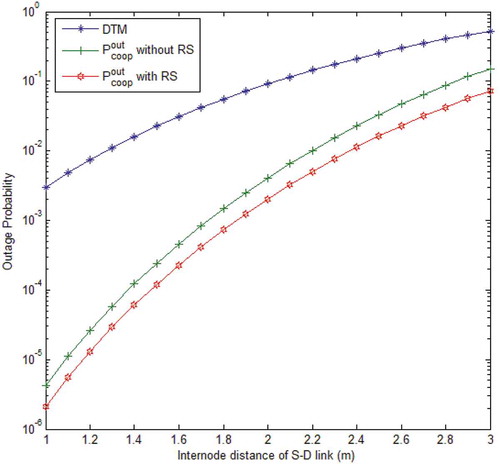
Figure shows the comparison of successful transmission probability of the DTM and ED-TMS protocol for different internode distance link. The successful transmission probabilities at sma all distance are approximately the same. We can see from Figure that, at large distance, the successful transmission probability of the ED-TMS with RS is better than DTM and ED-TMS without RS, respectively. At 2.9 m, the successful transmission probability improvements of ED-TMS with RS with respect to ED-TMS without RS and DTM are 2% and 18.5%, respectively. On the other hand, successful transmission probability improvement of ED-TMS without RS with respect to DTM is 17%.
Figure 3. Comparison of successful transmission probability of DTM and ED-TMS with internode distance of link, the
is 4,
,
and
.
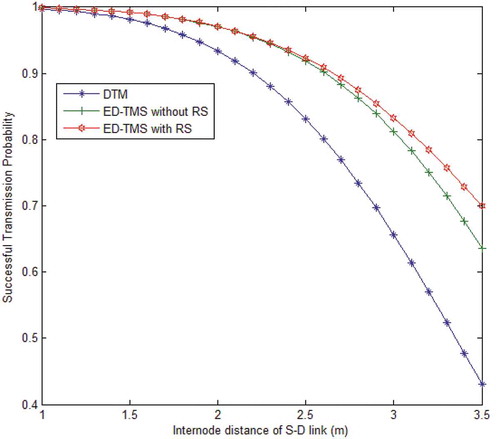
Figure shows the comparison of successful transmission probability of the ED-TMS protocol for different critical data index values of . As the
increases, the required successful transmission probability increases as well, in order to transmit the critical data efficiently over the wireless medium. We can also notice that the successful transmission probability of the ED-TMS with RS is better than ED-TMS by 6%.
Figure 4. Successful transmission probability of ED-TMS with. The internode distance 2.5 m of
link, the
is 5,
, and
.
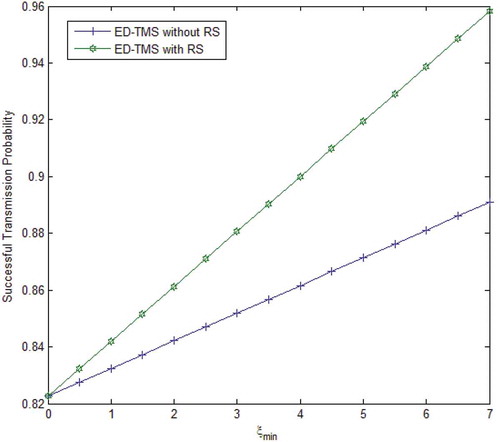
Figure shows the comparison of end-to-end delay of the DTM, MI-ICC, and ED-TMS protocol for different internode distance link. At a small distance, the performance of the ED-TMS without RS, DTM, and MI-ICC is approximately the same, while the ED-TMS with RS has a less end-to-end delay. The end-to-end delay of ED-TMS without RS at large distance is less than DTM and MI-ICC. At 3.4 m, the end-to-end delay reduction of ED-TMS with RS with respect to DTM, MI-ICC, and ED-TMS without RS are 24.5%, 28%, and 30%, respectively.
Figure 5. Comparison of end-to-end delay of DTM and ED-TMS with internode distance of link,
is 4,
,
, and
.
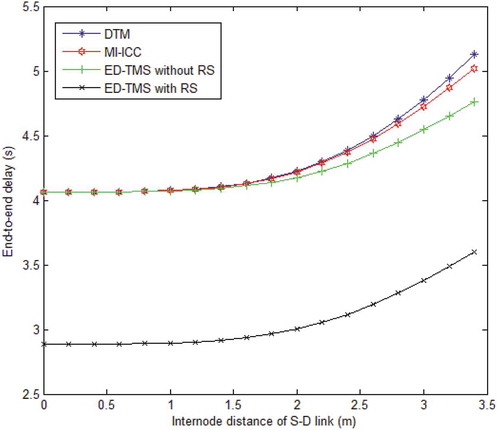
Figure shows the comparison of end-to-end delay of ED-TMS protocol for different critical data index values of. Similar to Figure , we can observe the end-to-end of ED-TMS with RS is better than ED-TMS without RS. In addition, as the
increases, the end-to-end delay increases as well.
Figure shows the comparison of throughput of the DTM, MI-ICC, and ED-TMS protocol for different internode distance link. At a small distance, the performance of the ED-TMS without RS, DTM, and MI-ICC is approximately the same, while the ED-TMS with RS has better throughput. At 3.4 m, the throughput improvement of ED-TMS with RS with respect to DTM, MI-ICC, and ED-TMS without RS are 14.5%, 6%, and 5%, respectively. Figure shows the comparison of the throughput of ED-TMS protocol for different critical data index values of
. The ED-TMS with RS improved the throughput with respect to ED-TMS without RS.
7. Conclusion
In this paper, we have proposed a novel CC aware types of gathered data based on IEEE 802.15.6 CSMA policy under Rayleigh fading channel, namely ED-TMS, for WBAN. We have also proposed a new RS strategy along with ED-TMS. The proposed protocol increased the probability of a successful transmission if the gathered data were critical, by selecting either the direct path or the relay path, while, if the gathered data were not critical, the data transmitted over the direct path. We have demonstrated that the ED-TMS can substantially enhance the successful transmission, reduced end-to-end delay, and enhanced throughput compared to DTM IEEE 802.15.6 CSMA and MI-ICC. As a future work, we will design and investigate MAC protocol for inter-WBAN cooperation.
Additional information
Funding
Notes on contributors

Ahmed Alkhayyat
Ahmed Alkhayyat received the B.Sc. degree in electrical engineering from AL KUFA University, Najaf, Iraq, in 2007, and the M.Sc. degree from the Dehradun Institute of Technology, Dehradun, India, in 2010. He contributed in organizing several IEEE conferences, workshop, and special sessions. He is currently a dean of international relationship and manager of the world ranking in the Islamic University, Najaf, Iraq. To serve his community, he acted as a reviewer for several journals and conferences. His research interests include network coding, cognitive radio, efficient-energy routing algorithms, and efficient-energy MAC protocol in cooperative wireless networks and wireless local area networks, WBAN, as well as cross-layer designing for self-organized network.
References
- Abbasi, Q. H. , Ur- Rehman, M. , Qaraqe, K. , & Alomainy, A. (Eds.). (2016). Advances in body-centric wireless communication: Applications and state-of-the-art . Series: IET telecommunications series. London: Institution of Engineering and Technology. ISBN 9781849199896.
- Ahmed, S. , Javaid, N. , Yousaf, S. , Ahmad, A. , Sandhu, M. M. , Imran, M. , … Alrajeh, N. (2015). Co-LAEEBA: Cooperative link aware and energy efficient protocol for wireless body area networks. Computers in Human Behavior , 51, 1205–1215. doi:10.1016/j.chb.2014.12.051
- Alkhayyat, A. (2015). Joint next-hop/relay selection for distributive multihop cooperative networks. Discrete Dynamics in Nature and Society , 2015, 10.
- Alkhayyat, A., & Sadkhan, S.B. (2018, May 8–9). Bandwidth efficiency analysis of cooperative communication with reactive relay selection. Proceedings of the International Conference on Engineering Technology and Their Applications (IICETA) (pp. 77–80), Al-Najaf, Iraq.
- Alkhayyat, A. , Gazi, O. , & Sadkhan, S. B. (2015). The role of delay and connectivity in throughput reduction of cooperative decentralized wireless networks. Mathematical Problems in Engineering , 2015, 10.
- Alomainy, A. , Bari, R. D. , Abbasi, Q. H. , & Chen, Y. (2014). Co-operative and energy efficient body area and wireless sensor networks for healthcare applications. Academic Press. Retrieved from https://doi.org/10.1016/C2013-0-18643-6
- Arain, W. M. , & Ghani, S. (2016). Meta-survey on medium access control surveys in wireless sensor networks. International Journal of Distributed Sensor Networks , 12(8), 1550147716662787. doi:10.1177/1550147716662787
- Cavallari, R. , Martelli, F. , Rosini, R. , Buratti, C. , & Verdone, R. (2014). A survey on wireless body area networks: Technologies and design challenges. IEEE Communications Surveys & Tutorials , 16(3), 1635–1657. doi:10.1109/SURV.2014.012214.00007
- Chavez-Santiago, R. , Sayrafian-Pour, K. , Khaleghi, A. , Takizawa, K. , Wang, J. , Balasingham, I. , & Huan-Bang, L. (2013). Propagation models for IEEE 802.15. 6 standardization of implant communication in body area networks. IEEE Communications Magazine , 51(8), 80–87. doi:10.1109/MCOM.2013.6576343
- Cui, J. , Sun, Y. , Wang, J. , & Ji, Y. (2017). Node-position-based joint relay selection and adaptive power control scheme in wireless body area networks. Wireless Personal Communications , 96(1), 1519–1535. doi:10.1007/s11277-017-4254-8
- Cui, J. , Sun, Y. , Wang, J. , & Yuefeng, J. (2017). Node-position-based joint relay selection and adaptive power control scheme in wireless body area networks. Wireless Personal Communications , 96(1), 1519–1535. doi:10.1007/s11277-017-4254-8
- Deepak, K. S. , & Babu, A. V. (2015). Improving energy efficiency of incremental relay based cooperative communications in wireless body area networks. International Journal of Communication Systems , 28(1), 91–111. doi:10.1002/dac.v28.1
- Elfituri, M. , Hamouda, W. , & Ghrayeb, A. (2009). A convolutional-based distributed coded cooperation scheme for relay channels. IEEE Transactions on Vehicular Technology , 58(2), 655–669. doi:10.1109/TVT.2008.927033
- Esteves, V. , Antonopoulos, A. , Kartsakli, E. , Puig-Vidal, M. , Miribel-Català, P. , & Verikoukis, C. (2015). Cooperative energy harvesting-adaptive MAC protocol for WBANs. Sensors (Switzerland) , 15(6), 12635–12650. doi:10.3390/s150612635
- Hayajneh, T. , Almashaqbeh, G. , Ullah, S. , & Vasilakos, A. V. (2014). A survey of wireless technologies coexistence in WBAN: Analysis and open research issues. Wireless Networks , 20(8), 2165–2199. doi:10.1007/s11276-014-0736-8
- Hiep, P. T. , Hoang, N. H. , & Kohno, R. (2015). Performance analysis of multiple-hop wireless body area network. Journal of Communications and Networks, 17(4), 419–427.
- Ibrahim, A. S. , Sadek, A. K. , Weifeng, S. , & Liu, K. J. R. (2008). Cooperative communications with relay-selection: When to cooperate and whom to cooperate with? IEEE Transactions on Wireless Communications , 7, 7. doi:10.1109/TWC.2008.070176
- Ibrahim, A. S. , Han, Z. , & Liu, K. R. (2008). Distributed energy-efficient cooperative routing in wireless networks. IEEE Transactions on Wireless Communications , 7(10), 3930–3941. doi:10.1109/T-WC.2008.070502
- Jang, J. , Kim, S. W. , & Wie, S. (2012). Throughput and delay analysis of a reliable cooperative MAC protocol in ad hoc networks. Journal of Communications and Networks , 14(5), 524–532. doi:10.1109/JCN.2012.00010
- Khalid, M. , Wang, Y. , Ra, I. H. , & Sankar, R. (2011). Two-relay-based cooperative MAC protocol for wireless ad hoc networks. IEEE Transactions on Vehicular Technology , 60(7), 3361–3373. doi:10.1109/TVT.2011.2159872
- Khan, P. , Ullah, N. , Alam, M. N. , & Kwak, K. S. (2015). Performance analysis of WBAN MAC protocol under different access periods. International Journal of Distributed Sensor Networks , 11(10), 102052.
- Khan, R. A. , & Pathan, R. (2018). The state-of-the-art wireless body area sensor networks: A survey. International Journal of Distributed Sensor Networks , 14(4), 1550147718768994. doi:10.1177/1550147718768994
- Lalos, A. S. , Antonopoulos, A. , Kartsakli, E. , Di Renzo, M. , Tennina, S. , Alonso, L. , & Verikoukis, C. (2015). RLNC-Aided cooperative compressed sensing for energy efficient vital signal telemonitoring. IEEE Transactions on Wireless Communications , 14(7), 3685–3699.
- Liao, Y. , Leeson, M. S. , Cai, Q. , Ai, Q. , & Liu, Q. (2018). Mutual-information-based incremental relaying communications for wireless biomedical implant systems. Sensors , 18(2), 515. doi:10.3390/s18020515
- Liu, P. , Tao, Z. , Narayanan, S. , Korakis, T. , & Panwar, S. S. (2007). CoopMAC: A cooperative MAC for wireless LANs. IEEE Journal on Selected Areas in Communications , 25, 2. doi:10.1109/JSAC-OCN.2007.022305
- Liu, Y. , Yuen, C. , Cao, X. , Hassan, N. U. , & Chen, J. (2014). Design of a scalable hybrid MAC protocol for heterogeneous M2M networks. IEEE Internet of Things Journal , 1(1), 99–111. doi:10.1109/JIOT.2014.2310425
- Mahapatra, R. , Nijsure, Y. , Kaddoum, G. , Hassan, N. U. , & Yuen, C. (2016). Energy efficiency tradeoff mechanism towards wireless green communication: A survey. IEEE Communications Surveys and Tutorials , 18(1), 686–705. doi:10.1109/COMST.2015.2490540
- Manirabona, A. , Fourati, L. C. , & Boudjit, S. (2015). Decode and merge cooperative MAC protocol for intra WBAN communication. 2014 IEEE 16th Int. Conf. e-Health Networking, Appl. Serv. Heal. 2014 (pp. 146–151). Natal, Brazil.
- Nhu, D. , Bao, V. , & Beongku, A. (2016). Outage performance analysis of relay selection schemes in wireless energy harvesting cooperative networks over non-identical rayleigh fading channels. Sensors , 16(3), 295. doi:10.3390/s16122100
- Rasheed, M. B. , Javaid, N. , Imran, M. , Khan, Z. A. , Qasim, U. , & Vasilakos, A. (2017). Delay and energy consumption analysis of priority guaranteed MAC protocol for wireless body area networks. Wireless Networks , 23(4), 1249–1266. doi:10.1007/s11276-016-1199-x
- Rout, D. K. , & Das, S. (2016a). Multi-relay cooperative body surface communications in ultra-wideband body area networks. Computers & Electrical Engineering , 50, 111–124. doi:10.1016/j.compeleceng.2016.02.006
- Rout, D. K. , & Das, S. (2016b). Multi-relay cooperative body surface communications in ultra-wideband body area networks. Computers & Electrical Engineering , 50, 111–124. doi:10.1016/j.compeleceng.2016.02.006
- Rout, D. K. , & Das, S. (2017). Reliable communication in UWB body area networks using multiple hybrid relays. Wireless Networks , 23(8), 2555–2570. doi:10.1007/s11276-016-1305-0
- Rout, D. K. , Gurrala, K. K. , & Das, S. (2016). Performance of amplify forward and decode forward cooperative strategies for body surface communications in UWB body area networks. International Journal of Communication Systems , 29(5), 916–928. doi:10.1002/dac.2994
- Shimly, S. M. , Movassaghi, S. , & Smith, D. B. (2016). Cooperative communications for sleep monitoring in wireless body area networks. Electronics Letters , 52(8), 594–596. doi:10.1049/el.2015.3008
- Tachtatzis, C. , Di Franco, F. , Tracey, D. C. , Timmons, N. F. , & Morrison, J. (2010, December 6). An energy analysis of IEEE 802.15. 6 scheduled access modes. In GLOBECOM workshops (GC Wkshps), 2010 IEEE (pp. 1270–1275). IEEE.
- Ullah, S. , Imran, M. , & Alnuem, M. (2014). A hybrid and secure priority-guaranteed MAC protocol for wireless body area network. International Journal of Distributed Sensor Networks , 10(2), 481761. doi:10.1155/2014/481761
- Wei, Z. , Sun, Y. , & Yuefeng, J. (2017). Collision analysis of CSMA/CA based MAC protocol for duty cycled WBANs. Wireless Networks , 23(5), 1429–1447. doi:10.1007/s11276-016-1230-2
- Yan, J. , Peng, Y. , Shen, D. , Yan, X. , & Deng, Q. (2018). A novel energy-efficient routing scheme based on artificial bee colony algorithm in wireless body area networks. 2018 International Conference on Computer, Information and Telecommunication Systems (CITS) (pp. 1–5). Colmar, France: IEEE.
- Yousaf, S. , Javaid, N. , Qasim, U. , Alrajeh, N. , Khan, Z. , & Ahmed, M. (2016). Towards reliable and energy-efficient incremental cooperative communication for wireless body area networks. Sensors , 16(3), 284. doi:10.3390/s16122100
- Zhang, Y. , Zhang, B. , & Zhang, S. (2017). A lifetime maximization relay selection scheme in wireless body area networks. Sensors , 17(6), 1267. doi:10.3390/s17050968

